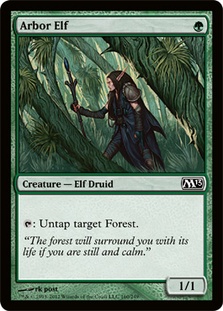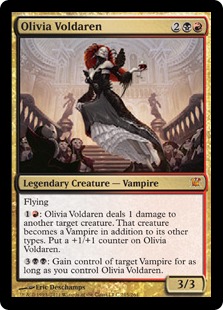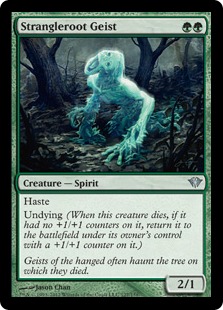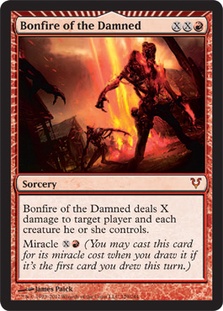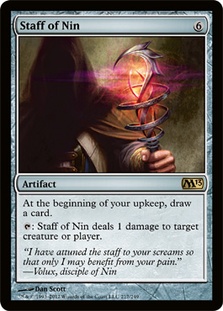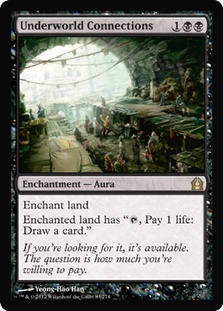The times that you do nearly everything right are the times when your mistakes stick with you the most. For Pro Tour Gatecrash, I felt that I’d done a great job in my preparation and in my deck choice, and it was only a single draft that separated a possible Top 8 from a lackluster 65th place result.
I played Arbor Elf Jund in Montreal, and my 8-2 record with the deck carried me to a money finish despite a lousy performance in the limited portion. Thankfully, the deck—a proud result of countless hours of testing and tuning—was saved from obscurity by Owen Turtenwald making Top 8 with the exact same 75.
Creatures (13)
Planeswalkers (5)
Lands (25)
Spells (17)

Between the three people who played it, Owen Turtenwald, Ben Seck, and myself, we put up a 17-6 Swiss record. I’m confident that Arbor Elf Jund was a great deck for the PT and has a bright future moving forward.
The Mana
Frequent readers of my column know that I’ve liked Standard Jund for quite some time. Well, I’ve also liked my 2001 Buick Century for quite some time, but it wasn’t until last month, when I got my broken muffler fixed, that I noticed how much that annoying rattling had been bothering me! There was always something not quite right about driving my car, and there was always something not quite right about playing Jund. A certain clunkiness that set it apart from other decks that have felt truly great to me over the years. For the Pro Tour, I feel we were finally able to solve the problem.
People have been asking me what Gatecrash has to offer for Jund: my answer is Arbor Elf! Of course, Arbor Elf was an existing card before Gatecrash, but you could never have considered playing it before the reprinting of Stomping Ground. With eight green dual lands, it’s now possible to reach an adequate number of Forests without shirking Jund’s intense requirements of black and red mana.
Arbor Elf allows Jund to come out faster, smoother, and better. Unlike Jund in Legacy and Modern, which have the luxury of curving smoothly from one mana to four, Standard Jund plays a little more like a ramp deck where it can’t truly get going until it reaches the four-mana mark. The deck strikes a delicate balance; since you need lots of mana to operate, it’s tempting to play a very high land count. However, that opens up the problem of flooding out in the late game because you lack a card like Sphinx’s Revelation to really sink your mana into. You could play more high-impact spells like Staff of Nin and Olivia Voldaren, but if you skimp too much on cheap plays, you’ll get run over before you even start casting your spells!
The deck needed a bit more mana, but simply playing vanilla lands every turn of the game is not good enough. I tried Rakdos Keyrune to smooth things out by simulating both a ramp spell and a manland, but it didn’t do a great job as either one. The deck either needs to accelerate to four mana quickly or to make powerful relevant plays in the early turns. What was really needed was extra Farseeks, but no such card existed in Standard before Gatecrash.
Arbor Elf is the closest thing to Farseeks five through seven, and in many ways, it’s better! Many unhappy opponents fell victim to 9/1 trampling Arbor Elves, attacking on turn 12 with the help of Kessig Wolf Run; I’d like to see a Farseek do the same thing. Or how about a turn 3 Thragtusk or Garruk, Primal Hunter? Impossible with two Farseeks, but a common occurrence when you can divide your ramp spells between turns 1 and 2. The Arbor Elf nut draw is a turn 2 Liliana of the Veil off of an Elf and an Overgrown Tomb. Note that this is the only popular deck in the format capable of such a feat!
If Arbor Elf is so great, why are there not four copies? The short answer is that I wanted to play a number small enough to maintain the strengths of traditional Jund. With so much one-for-one removal, it’s dangerous to jam too many mana sources into Jund because you put yourself at risk of flooding out. Of course, you could cut a land for a fourth Elf, but what’s the point of ramping your mana if you’re going to miss your land drops anyway? Long testing showed 25 to be the right number of lands for the deck, and I wouldn’t want to risk missing land drops or cheating on colored sources.
What’s more is drawing multiple Elves can put you at risk of a number of things. The first is a sweeper; Supreme Verdict is not traditionally a great card against Jund, but if it can simultaneously take away your pressure and your mana, it can cause a problem. Additionally, the majority of Jund and Naya decks have Bonfire of the Damned for midrange creature mirrors. The second risk is simply having a clunky draw; spending too much time on ramp and not enough time affecting the board. The third risk is drawing multiple Elves without a Forest!
Eleven Forests is not a ton to support Arbor Elf, but I think it’s the best way to go. Drawing one basic Forest is often nice, but drawing two can make casting the double black spells and the red/black gold cards difficult. Having a hand with Arbor Elf and no Forest isn’t the end of the world either because you’ll still be able to use the mana when you inevitably find your Forest later in the game. In conclusion, the presence of three Forests and three Arbor Elves gives the deck a much-needed speed boost without interfering with the strengths of the old Jund deck.
The only concession to Arbor Elf is the loss of Cavern of Souls, but that hasn’t bothered me at all since many control decks only run a couple of Dissipates in their maindeck. Besides, it’s really the noncreature spells that you want to resolve in those matchups anyway.
The Creatures
Thragtusk and Huntmaster of the Fells have been accepted four-ofs since the deck’s conception. They remain the best way to turn a game against aggro and are among the most powerful and efficient cards in standard.
Now that the Jund mirror is becoming a real concern, I feel I should expand on my love for Olivia Voldaren. The last Olivia standing will win the game with almost no questions asked. Facing down an Olivia is an awful feeling because you can’t even cast the creatures in your hand. She’s particularly frightening because the most common removal spells in the format don’t kill her. Pillar of Flame, Dead Weight, Abrupt Decay, Ultimate Price, Victim of Night, and Bonfire of the Damned all come up short. She’s the biggest reason why we found room for a Dreadbore and two Murder in the 75. To be brutally honest, though, the best answer to an opposing Olivia is the legend rule!
A notable omission is Vampire Nighthawk, which is a card that’s been good to me in the past. Its low power leaves something to be desired against control. While good against red decks, everyone is prepared to face it, and it doesn’t substantially change the matchup. With Arbor Elves, we felt that we could bypass that spot on the mana curve and have a greater chance of going straight to Huntmasters and Thragtusks, which are more reliable at locking up the game.
Instead of Nighthawk, Strangleroot Geist was our creature of choice against Mono-Red Aggro. It does a stellar job of holding the ground and is resilient to the removal they’re likely leave in against you. If it chump blocks twice, it’s done a great job; if it trades once and chumps once, it’s insane; if it trades twice, which does happen, you’ll have a hard time losing the game even if you try! The best thing about it is that it can hold off an army of 2/2s, allowing you to save your removal for Boros Reckoners, Hellriders, and Thundermaw Hellkites. Thus, it helps protect you from both of Mono-Red Aggro’s most common ways to beat you: the early game swarm and the midgame bombs!
Geist is also a welcome addition against Esper since it’s resilient to both spot removal (particularly Edict effects) and against sweepers. It’s great against planeswalkers and great with Kessig Wolf Run.
Geist did exactly what I wanted it to do at the Pro Tour. That said, I’ll admit that I overestimated the amount of Mono-Red Aggro that would be played. With no Mono-Red in the Top 8 either, I could be convinced to leave the Geists on the sidelines until it has a resurgence.
The Removal
Similar to Strangleroot Geist, Pillar of Flame can be an unexciting card but earns its place specifically for the fast beatdown matchups. It remains an important way to deal with undying creatures, Doomed Traveler, and Gravecrawler, though those cards only pop up once in a while these days. One mana for two damage is still the best rate you can find against Mono-Red Aggro, and I prefer Pillar to Dead Weight in the maindeck because it can hit planeswalkers or go to the face, whereas Dead Weight is likely to be a purely dead card against control. With Tom Martell winning the Pro Tour with Falkenrath Aristocrat, Tragic Slip’s value will go up relative to Pillar of Flame.
The other way to control weenie creatures is Bonfire of the Damned. I would be very uncomfortable if I was to play neither Bonfire nor Mizzium Mortars in Jund; you need some kind of crowd control. While both cards are very good, we opted for Bonfire in the PT because of our relatively low count of red lands (a sacrifice we made for Arbor Elf). But again, because of Martell’s win and the guaranteed presence of Lingering Souls in the coming weeks, I’ll be sticking with Bonfires.
The biggest change brought about by Gatecrash is Boros Reckoner—arguably the top "must-kill" creature in standard. Abrupt Decay does the job best, and Ultimate Price and red removal come up short. We still included one copy of Ultimate Price since it’s the best for Hellrider, Thundermaw Hellkite, and Restoration Angel and will rarely be stone-cold dead. Two Abrupt Decay is the number we wanted against control decks with Detention Sphere and against Flash decks with Runechanter’s Pike, so I wouldn’t go lower than that. One Dreadbore is a nice catchall and I could see playing two, but sorcery speed removal is bad against haste, bad against flash, bad against opposing Kessig Wolf Runs, and less than ideal with your own Huntmaster of the Fells.
Finally, we come to what proved to be one of the most valuable cards in the deck: Murder. With all of the flashy rare removal spells legal in Standard, I never expected to be playing with the actual card Murder at the Pro Tour. However, it’s simply perfect! There’s no reason for me to list the creatures it kills for you because it kills everything! No other removal spell can kill both Boros Reckoner and Olivia Voldaren. What about Obzedat, Ghost Council? My personal favorite use of the card is to pass the turn, offering to flip both players’ Huntmasters, and then blow them out by Murdering theirs!
The Noncreature Threats
One of the great things about Jund is its ability to fight on multiple levels. So often at the PT, my opponents would overprepare for my creatures, only to lose to a planeswalker or another of my powerful noncreature threats. Liliana of the Veil remains one of the most powerful cards against control, and she comes down fast enough that they’re seldom prepared with a counterspell.
Similarly, Garruk, Primal Hunter can absolutely dominate a game against control. I was also very impressed with him in midrange creature mirrors. His function as a "Super Tidings"—drawing five cards off of a Thragtusk the turn you play him (sometimes more off of Olivia or a Kessig Wolf Run)—is typically enough to lock up the game.
Rakdos’s Return is a huge reason to play Jund, and it’s only gotten better with Arbor Elf! Between Liliana of the Veil, Duress, and Rakdos’s Return, the hand is no longer a safe place for your opponent’s powerful cards. You force them into a situation where they hope to peel their bombs at the right time rather than plan the game around one that’s already in their hand. That would be a fine plan except that Jund has a remarkable ability to kill someone fast between its high-power creatures, Fireballs, and Kessig Wolf Run.
Last but certainly not least, we come to the four Howling Mine cards we played at the Pro Tour. Staff of Nin is the Jund mirror-breaker. It’s the only card that can never be answered and almost inevitably leads to a win. You take a turn to cast it and perhaps take some combat damage right there, but soon you’re drawing into an endless stream of life gain creatures and removal spells.
Underworld Connections is slower and more risky since you’re paying both life and mana for the effect each turn, but it has many advantages, which is the reason for the 2-2 split. In the Jund mirror, Connections has the unique ability to come down before a Rakdos’s Return and help you recover from it after the fact. Against control and Flash, it comes down too early to counter and can easily be set up with a Duress. Finally, don’t overlook the interaction with Arbor Elf! Put Underworld Connections on a Forest and suddenly you’ve turned your cards that might otherwise be weakest in the late game into additional Howling Mines!
Conclusion
Standard is a diverse and terrific format; you can truly play whatever you deck suites you. However, I’m certain that Jund is at least among the best choices, and what I’ve offered above is a finely tuned list with great game against everything. I’d recommend it for a StarCityGames.com Open, a Grand Prix, the Magic Online Championship, or any other Standard event you have coming up!
Coming soon will be an updated decklist, along with a sideboarding guide and in-game tips and tricks. Stay tuned!

